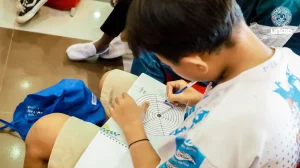Coronavirus disease 2019 (COVID-19) is a pandemic that has been going on since 2019. The disease is caused by acute respiratory syndrome coronavirus 2 (SARS-CoV-2). Polypeptides are processed by the main protease or 3C-like protease (MPro or 3CLPro), which is responsible for the coronavirus replication cycle. More specifically, the subsite binding pocket SARS-CoV-2 main protease contains His41 and Cys145 residues, which play a crucial role as catalysis centers. It is the main focus variable needed to understand because the subsite binding pocket plays a crucial role in the inhibitory mechanism of SARS-CoV-2 main protease. Studies on the interaction of inhibitors with amino acid residues in the subsite binding pocket are expected to be a solution to increase the development possibility of SARS-CoV-2 main protease inhibitors.
Several reports state that natural product compounds have potential as SARS-CoV-2 main protease inhibitor. Some of them that have been reported are diterpene derivatives that have the inhibitor activity of SARS-CoV main protease. The report provides information that the diterpene derivative has the potential to inhibit the main protease of SARS-CoV-2. Several works of literature give similar recommendations about the potential of diterpenes as a promising SARS-CoV-2 main protease inhibitor. One of them is dolabellane derivative (isolated from Caribbean Eunicea laciniata and Nigella damascena) which is a subclass ditepene. These compounds are the main focus to investigate their potential as candidate inhibitors in this study. They are chosen because Some research reported dolabellane compounds had potential as antivirals. Hopefully, this research can provide information about the potential of dolabellane derivatives as inhibitors against the main protease SARS-CoV-2. The combination of molecular docking and Molecular Dynamic (MD) simulation provides a comprehensive, structure-based approach in studying the interaction of inhibitors with the SARS-CoV-2 main protease at the molecular level. In particular, the interaction of the inhibitor with amino acid residues at the subsite binding pocket.
One of them is dolabellane derivative (isolated from Caribbean Eunicea laciniata and Nigella damascena) which is a subclass ditepene. These compounds are the main focus to investigate their potential as candidate inhibitors in this study. They are chosen because Some research reported dolabellane compounds had potential as antivirals. Hopefully, this research can provide information about the potential of dolabellane derivatives as inhibitors against the main protease SARS-CoV-2. The combination of molecular docking and Molecular Dynamic (MD) simulation provides a comprehensive, structure-based approach in studying the interaction of inhibitors with the SARS-CoV-2 main protease at the molecular level. In particular, the interaction of the inhibitor with amino acid residues at the subsite binding pocket. The calculation of binding affinity(∆Gbind) using the MM-PB/GBSA approach showed that the DD13 candidate ΔGbind showed more promising inhibition criteria for the 3CLpro enzyme than ML188 (kontrol positif) and the other 13 diterpene candidates. This result was strengthened by the interaction of the DD13 on the subsite binding pocket of the 3CLpro enzyme with energy decomposition showed residue < -1.00 kkal/mol at His41 and Cys145. Furthermore, the DD13 candidate showed promising ADMET properties criteria as a drug candidate with criteria +HIA, −BBB, non-inhibitor of cytochrome isoenzymes, and non-toxic.
Author: Dr. Nanik Siti Aminah, M.Si
Complete article published by “RSC Advances”:
“The Doblabellane Diterpenes as Potential Inhibitors of Main Protease SARS-CoV-2: Molecular Insight of Inhibitory Mechanism through Computational Studies”
Authors: Nanik Siti Aminah (Universitas Airlangga), Muhammad Ikhlas Abdjan (Universitas Airlangga), Andika Pramudya Wardana (Universitas Airlangga), Alfinda Novi Kristanti (Universitas Airlangga), Imam Siswanto (Universitas Airlangga), Khusna Arif Rakhman (Universitas Khairun), Yoshiaki Takaya (Meijo University, Japan)
Link:
https://pubs.rsc.org/en/content/articlelanding/2021/ra/d1ra07584e









